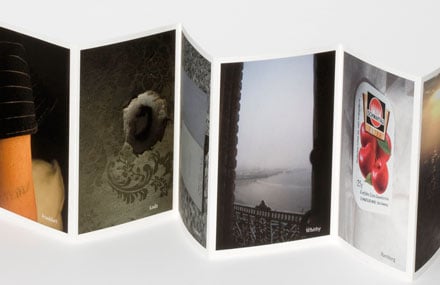Sarah Bodman is Senior Research Fellow for Artists’ Books at the Centre for Fine Print Research at the University of the West of England, author of Creating artists’ books and editor of Artist’s book yearbook and the journal The blue notebook. Here she answers some questions about artists’ books ahead of her lecture at the Library tonight – Books of all stripes: artists’ publishing in the 21st century.
Q. What is it about books as an artistic medium that excites you?
Everything! A book as a work of art has so many possibilities from an exquisite, finely printed book to a scrappy photocopy zine, however it is made, it can be a magical experience to open and find out what is inside. The book as a democratic multiple allows an engagement with an audience inside or outside of art galleries, and that is something that is very exciting to me.
Q. In your experience are artists’ books under-recognised?
I don’t think they are under-recognised, admittedly they aren’t as big as painting or sculpture but there is a huge interest in the book arts and plentiful activity.
Q. Is there something secret or revelatory about an artwork that exists between its front and back covers?
Yes, there is. You never really know what you are going to find when you open a book, and sometimes the exterior can be very different to the interior, for example, Finlay Taylor’s Trail, housed in a lovely slipcase and covers, opens to reveal snail eaten texts.
Q. Should artists’ books be touched and read or observed from a safe distance?
Touched and read wherever possible!
Q. A book artist once said that he likes to think that books speak to each other on the shelf. Which books would you like to see speaking to each other?
I have seen books that do speak to each other, Les Coleman made a book called With my Right Hand (White Lies Publications, 1982), where he made a series of drawings in an exercise book using his right hand (he is left handed), the artist Erica van Horn later made a book in response called With my Left Hand (Coracle 2006). I would like to see some books speak to Amir Brito Cador’s book A Night Visit to the Library (http://gramatologia.blogspot.com).
He made this book in response to Endre Tót’s book, A Night Visit to the National Gallery, and he asks if we can recognise a book by its silhouette. Inside the book are silhouettes of his favourite artists’ books, so I would love some other books to speak to this book.
Q. With the rapid growth of digital information and electronic book readers, do you think artists’ books are becoming more or less important? Can they or should they translate into electronic texts?
I would say with the developments in digital technology that artists’ books are becoming more important, they can and do translate into electronic texts and artists are exploring publishing through free e-readers such as Calibre. The French artist Nicolas Frespech has made a whole series of books with QR codes, that can be read through mobile phones or e-readers (http://frespech.com/ebook/). With the growth of e-readers, mainstream and small independent publishers are already developing more intricate books that appeal to the collectors market, Visual Editions for example (http://www.visual-editions.com), so I think artists’ books will also grow as beautiful or physical objects that people want to hold.
Q. Melbourne is a UNESCO City of Literature. How do you think a City of Literature should support the book arts?
Melbourne already supports the book arts, especially at the State Library where you have a wonderful collection and an ongoing series of amazing exhibitions and events.
Literature and the book arts have a great relationship, as most people who appreciate literature also love books as physical objects so the interest and support is naturally there.
And you have so many talented artists in the area including the wonderful Gracia & Louise, currently in your Fine Impressions exhibition, who have just made two special collages for The Big Issue’s ‘Twelve Tales’, Fiction Edition Special (No 388, 30 August– 12 September, 2011), so literature and the book arts do cross over with each other quite often.
Q. What happens when text and image collide?
You get a wonderful explosion of creativity! Radoslaw Nowakowski is a wonderful example of this, his visual texts are just great, and his liberature works are texts as art, especially his hypertext works that you can see online (http://www.liberatorium.com).
Q. How many artists’ books have you seen that finish with ‘The End’?
None yet.
Q. What is the most impressive artist’s book you’ve ever seen?
Impressive in concept: Michael Landy’s Break Down Inventory or Sophie Calle and Paul Auster’s Double Game; the beautiful and harrowing books made by Ann Tyler Souvenirs or Billy Rabbit… I could go on and on. I can’t single out one book as the most impressive, I love too many of them for so many reasons!
The State Library presents Sarah Bodman
Books of all stripes: artists’ publishing in the 21st century
In this lecture, artists’ books specialist Sarah Bodman presents contemporary works from Europe and further afield, reflecting the variety of 21st-century book arts – from beautiful, traditional printed works to online publishing projects, altered books, performance books and video books.
Information on the artists featured in Sarah’s lecture and a PDF of the slideshow are available on the University of the West of England’s Book arts website.
Date Monday 26 September 2011, 6:00pm – 7:00pm
Cost Free
Bookings Book online 03 8664 7099 [email protected]
Venue Village Roadshow Theatrette, Entry 3, La Trobe St, Melbourne

Flowers in Hotel Rooms Volume IV (detail), Sarah Bodman, 2009, Bristol, UK

